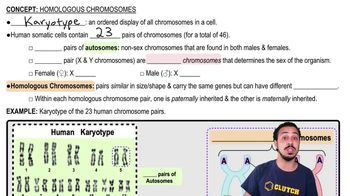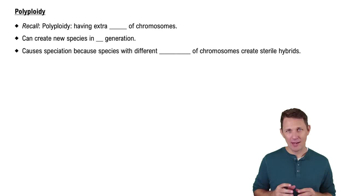Table of contents
- 1. Introduction to Biology2h 42m
- 2. Chemistry3h 40m
- 3. Water1h 26m
- 4. Biomolecules2h 23m
- 5. Cell Components2h 26m
- 6. The Membrane2h 31m
- 7. Energy and Metabolism2h 0m
- 8. Respiration2h 40m
- 9. Photosynthesis2h 49m
- 10. Cell Signaling59m
- 11. Cell Division2h 47m
- 12. Meiosis2h 0m
- 13. Mendelian Genetics4h 44m
- Introduction to Mendel's Experiments7m
- Genotype vs. Phenotype17m
- Punnett Squares13m
- Mendel's Experiments26m
- Mendel's Laws18m
- Monohybrid Crosses19m
- Test Crosses14m
- Dihybrid Crosses20m
- Punnett Square Probability26m
- Incomplete Dominance vs. Codominance20m
- Epistasis7m
- Non-Mendelian Genetics12m
- Pedigrees6m
- Autosomal Inheritance21m
- Sex-Linked Inheritance43m
- X-Inactivation9m
- 14. DNA Synthesis2h 27m
- 15. Gene Expression3h 20m
- 16. Regulation of Expression3h 31m
- Introduction to Regulation of Gene Expression13m
- Prokaryotic Gene Regulation via Operons27m
- The Lac Operon21m
- Glucose's Impact on Lac Operon25m
- The Trp Operon20m
- Review of the Lac Operon & Trp Operon11m
- Introduction to Eukaryotic Gene Regulation9m
- Eukaryotic Chromatin Modifications16m
- Eukaryotic Transcriptional Control22m
- Eukaryotic Post-Transcriptional Regulation28m
- Eukaryotic Post-Translational Regulation13m
- 17. Viruses37m
- 18. Biotechnology2h 58m
- 19. Genomics17m
- 20. Development1h 5m
- 21. Evolution3h 1m
- 22. Evolution of Populations3h 52m
- 23. Speciation1h 37m
- 24. History of Life on Earth2h 6m
- 25. Phylogeny2h 31m
- 26. Prokaryotes4h 59m
- 27. Protists1h 12m
- 28. Plants1h 22m
- 29. Fungi36m
- 30. Overview of Animals34m
- 31. Invertebrates1h 2m
- 32. Vertebrates50m
- 33. Plant Anatomy1h 3m
- 34. Vascular Plant Transport1h 2m
- 35. Soil37m
- 36. Plant Reproduction47m
- 37. Plant Sensation and Response1h 9m
- 38. Animal Form and Function1h 19m
- 39. Digestive System1h 10m
- 40. Circulatory System1h 57m
- 41. Immune System1h 12m
- 42. Osmoregulation and Excretion50m
- 43. Endocrine System1h 4m
- 44. Animal Reproduction1h 2m
- 45. Nervous System1h 55m
- 46. Sensory Systems46m
- 47. Muscle Systems23m
- 48. Ecology3h 11m
- Introduction to Ecology20m
- Biogeography14m
- Earth's Climate Patterns50m
- Introduction to Terrestrial Biomes10m
- Terrestrial Biomes: Near Equator13m
- Terrestrial Biomes: Temperate Regions10m
- Terrestrial Biomes: Northern Regions15m
- Introduction to Aquatic Biomes27m
- Freshwater Aquatic Biomes14m
- Marine Aquatic Biomes13m
- 49. Animal Behavior28m
- 50. Population Ecology3h 41m
- Introduction to Population Ecology28m
- Population Sampling Methods23m
- Life History12m
- Population Demography17m
- Factors Limiting Population Growth14m
- Introduction to Population Growth Models22m
- Linear Population Growth6m
- Exponential Population Growth29m
- Logistic Population Growth32m
- r/K Selection10m
- The Human Population22m
- 51. Community Ecology2h 46m
- Introduction to Community Ecology2m
- Introduction to Community Interactions9m
- Community Interactions: Competition (-/-)38m
- Community Interactions: Exploitation (+/-)23m
- Community Interactions: Mutualism (+/+) & Commensalism (+/0)9m
- Community Structure35m
- Community Dynamics26m
- Geographic Impact on Communities21m
- 52. Ecosystems2h 36m
- 53. Conservation Biology24m
22. Evolution of Populations
Genetic Variation
Problem 8
Textbook Question
A new plant species C, which formed from hybridization of species A(2n = 16) with species B(2n = 12), would probably produce gametes with a chromosome number of a. 12. b. 14. c. 16. d. 28.
 Verified step by step guidance
Verified step by step guidance1
Determine the haploid chromosome number (n) for each parent species. For species A, 2n = 16, so n = 16/2 = 8. For species B, 2n = 12, so n = 12/2 = 6.
When hybridization occurs, the resulting hybrid species C will initially have a chromosome number equal to the sum of the haploid numbers of the parent species. Therefore, the initial chromosome number of species C is 8 + 6 = 14.
In order for species C to produce viable gametes, it must undergo chromosome doubling (polyploidy) to restore homologous pairing during meiosis. This process results in a new species with a chromosome number of 2 × 14 = 28.
The gametes produced by species C will have half the chromosome number of the polyploid individual. Therefore, the gametes will have a chromosome number of 28/2 = 14.
Based on this reasoning, the correct answer is the gametes of species C would have a chromosome number of 14.
 Verified video answer for a similar problem:
Verified video answer for a similar problem:This video solution was recommended by our tutors as helpful for the problem above
Video duration:
31sPlay a video:
Was this helpful?
Key Concepts
Here are the essential concepts you must grasp in order to answer the question correctly.
Chromosome Number and Gametes
In sexually reproducing organisms, the chromosome number is typically represented as diploid (2n), which includes two sets of chromosomes. Gametes, or sex cells, are produced through meiosis and are haploid (n), containing half the number of chromosomes. Understanding how to derive the haploid number from the diploid number is essential for determining the chromosome count in gametes.
Recommended video:
Guided course

Homologous Chromosomes
Hybridization and Polyploidy
Hybridization occurs when two different species interbreed, resulting in offspring that may have a combination of traits from both parents. In some cases, hybridization can lead to polyploidy, where the offspring have more than two sets of chromosomes. This concept is crucial for predicting the chromosome number of the new species formed from species A and B.
Recommended video:

Polyploidy
Calculating Gamete Chromosome Number
To calculate the chromosome number of gametes produced by a hybrid species, one must first determine the diploid number of the hybrid. In this case, species A has 16 chromosomes (2n = 16) and species B has 12 chromosomes (2n = 12). The hybrid species C would likely have a diploid number that is the sum of the two, leading to a haploid number that can be calculated for gamete formation.
Recommended video:
Guided course

Homologous Chromosomes

 2:16m
2:16mWatch next
Master Sources of Genetic Variation with a bite sized video explanation from Jason
Start learningRelated Videos
Related Practice





























